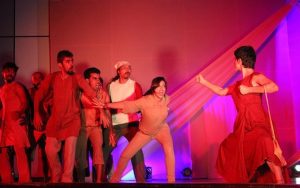Pakistani Theatre Then And Now
With roots stretching back to the third century BC, performing arts is one of South Asia’s most enduring cultural practices. Hinduism had a major effect on the theatre in this area, which originated in the era along the Indus River.

Theatre in South Asia has a long history extending back to the middle of the third century BC, drawing influence from rich Sanskrit literature. Hinduism initially inspired it, and it later developed into a folk culture and an artistic form in the Southeast. However, professional theatre began to develop in the 19th century, with Urdu dramas taking the front stage. During the East India Company era, plays from London imposed British culture on the Indian subcontinent.
From Imperial Impact to Post-Independence Variety: The Development of Pakistani Theatre:
“The subcontinent’s dramatic diversity reached its peak during the pre-colonial era. However, it has been difficult to determine the industry’s post-independence course in the area.

After the British left, Pakistan inherited two different styles of theatre: one that served the elite with English versions offered at art councils, and the other that offered Pakistani material in the form of jugats or jokes for the general public. Concurrent with this, a new generation of plays began to explore social and political refers instead of slapstick comedies or English translations. Stage plays were the major form of upscale public entertainment during the height of Pakistani theatre.
The Evolution of Theatre in Pakistani Cities:
Stage dramas developed in places like Karachi and Lahore, where names like Khwaja Mueenddin and Bano Qudsia came to symbolize the local theatre scene. Political upheaval in the 1970s placed limitations, limiting the golden age of the arts and entertainment. The formerly popular kind of public entertainment with limitations on the most risky performances moved into exclusive venues.

However, as groups like Tehreek Niswaan and Ajoka Theatre created as pillars of resilience by hardship turned into the delivering ground for social justice theatre. Pakistani theatre changed to fit a new context and audience when obstacles were relaxed.
The Changing Face of Pakistani Theatre: From Artistic Expression to Commercialization:
Analyze how the search for simple entertainment, the growth of dancing groups, and the growing popularity of musicals led to a shift in the nature of the Pakistani theatre scene. Major movie theatres in Karachi, Lahore, and Rawalpindi have been turned into theatres, generating worries about the commercialization of theatre.

Muhammad Qavi Khan, a seasoned performer, comments on the changes and raises concerns about how the business is changing. He considers the effects of marketing and regrets the lack of meaning in scripts and the preference for financial gain over creative integrity. The conversation touches on the changing education of theatre artists and the difficulties in preserving the creative quality of the field against the lure offered by modern production methods and marketing hype.
PNCA’s Efforts to Train Young Actors for Non-Commercial Theatre in Pakistan:
Former PNCA Director Dr. Waqar Ahmed spoke about a forthcoming theatrical workshop in an interview with The Express Tribune. The workshop’s goal is to prepare young performers for non-commercial dramas and envision their contribution to the transformation of the Pakistani theatre scene.









